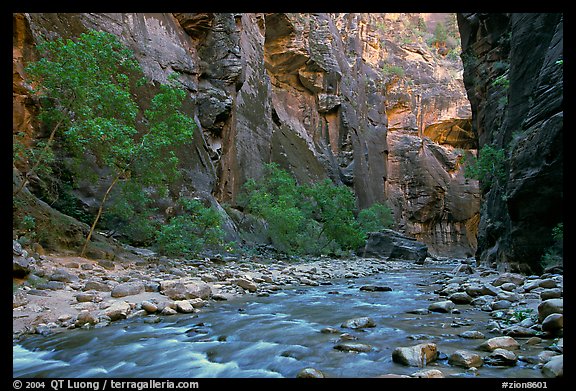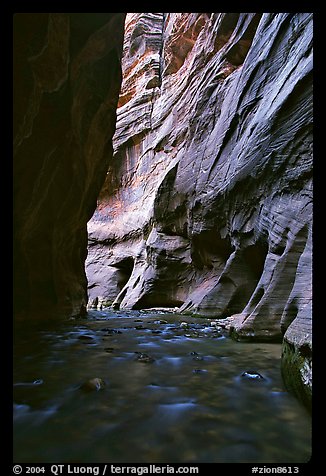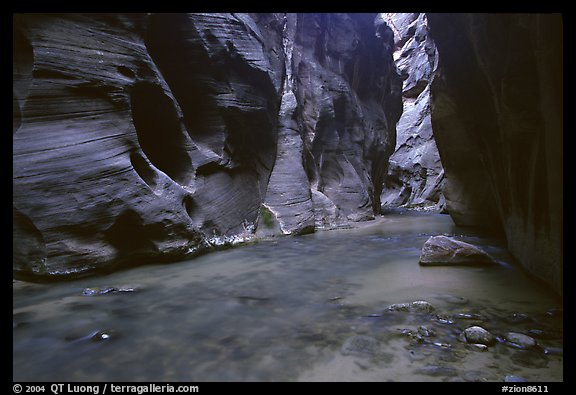Photo spot 10 : Zion National Park – The Narrows
One Comment
Zion National Park has sometimes been called a “Yosemite in color”. The comparison is apt, since both share a great variety of beauty, both in large scenery and intimate details. Like Yosemite, Zion features at its heart a narrow valley with a beautiful river and vegetation, flanked by sheer cliffs and rock towers.
However, unlike Yosemite, the Zion valley hasn’t been carved by glaciers, but instead by the Virgin River. The rock isn’t granite, but sandstone. This soft rock has allowed the river to gouge the Narrows, a deep gorge which in some places is only a dozen of feet wide, between walls that reach a thousand of feet high and spread only slightly to reveal a narrow sliver of sky. Hiking into the Narrows is one of the most unique experiences to be had in a national park, as you are most of the time wading in the river itself.
When to go is decided by a combination of factors. You’ll want to avoid high water flow (spring run-off from March to late May, later in years of heavy snowfall), flash flood danger (at its highest during the monsoon season in summer – if there is a risk of thunderstorm, the Park service will close the Narrows to hiking), high traffic (during the summer), and freezing temperatures (in winter).
My preferred time of the year to hike the Narrows would be in the late autumn. The small maple trees growing on the riverbanks turn shades of yellow and orange. The water level is at its lowest, which makes it easier to carry camera equipment. The cold water temperatures discourage crowds, which are much more abundant in the spring, and at their peak in the summer.
The key is to equip yourself appropriately by renting from an outfitter in Springsdale. At a minimum, canyoneering shoes will help protect your feet from the rocks that litter the riverbed, as well as provide you enough traction to avoid slipping – and falling in the water with your camera equipment – while neoprene socks will keep your wet feet warm. If the temperatures are cold, a dry suit would be useful as well, but don’t worry, as the outfitter will advise you. If you are going to be in the canyon all day, take a warm jacket for the return trip, as temperatures dip in late afternoon.
You also need something to help with your balance, as well as prob the river depth, since the water is not clear enough for you to see the bottom. At the start of the wet part of the hike, there is usually a stockpile of sticks that you can borrow, but a pair of hiking poles is more efficient. Or you could just use your extended tripod. It gets heavy in your hands, but you’d lighten your pack and be able to set-up faster.
The hike starts at the end of Zion Canyon with a mile-long surfaced trail called the River Walk, which in itself is quite nice. At the end of that trail almost everyone turns around, but you will simply step down into the river to continue.
During the fall, in the lower part of the Narrows, the water is between ankle and knee-high, and you can sometimes walk on the edge of the stream, but a few miles up, you may encounter pools that are waist-high.
You could hike up the Narrows for two days (although usually overnight trips are done in the opposite direction, down river, using a shuttle), but to see the narrowest part of the canyon, you just have to go a bit beyond the junction with the Orderville canyon, which takes about 1 hour and half to reach from the end of the Riverside Walk. Another hour and half makes it possible to reach the other end of the narrowest part. You should start as early as you can, so that you reach the narrowest part by mid-day, when there is more light. At the least, you should hike about half an hour to the Mystery Falls.
Like in many locations in the South West, you will be photographing in reflected light, avoiding directly lit spots (that produce excessive contrast). Even by mid-day, it can get quite dark in the canyon, especially during the fall. You will also be making many compositions with moving water, for which a slow shutter speed can be desirable. For both those reasons, a tripod is essential. It is wise to pack your equipment so that a fall in the water would not ruin it. A specialized water proof photo backpack would be handy, although I just used ziplock bags inside a regular backpack. In many places, the canyon exposes a small riverbank where you can set up your gear.



More images of the Zion Narrows
View all images of Zion National Park


Thank you for the excellent beta on this hike QT. Excellent collection of Zion photos you have also. I really enjoyed them. I just found your blog; I will be continuing down the page through your other posts.